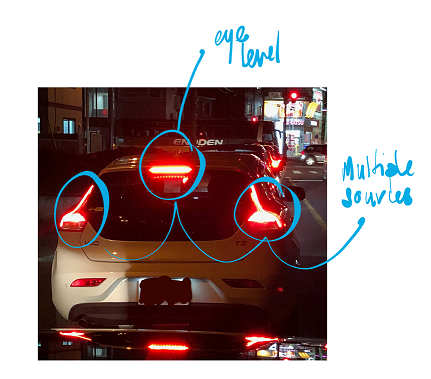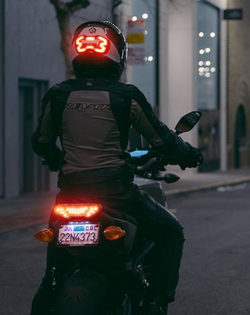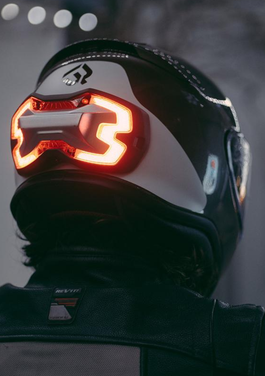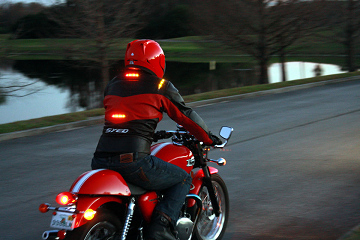1. Final Project - Concept¶
GY-RO9 Wings - Wearable Safety Enhancement Device for Motorcyclists¶

GY-RO9 Wings was conceived as a romantic solution to the problem of poor visibility of motorcyclists at night.¶
On the road, in darkness, motorcylists are nearly invisible…particularly from behind…which puts them at risk of being struck by approaching vehicles. With all the technological advancements that have been made with motorcycles, little progress has been made with regards to gear worn by the motorcycle rider. Motorcycle gear prioritizes the projection of “attitude”…a cool, tough rider…a rebel, a racer…a mounted knight, a Centaur hero. Practicality and safety are secondary in importance. It’s time for motorcycle gear to make some an evolutionary leap.
Motorcycling is both a technical and romantic pursuit.¶
Style matters when it comes to what a motorcylist will wear. Motorcyclists don’t want to just get from place to place, they also want to look good and feel good doing it. No self-respecting motorcyclist wants to wear the pragmatic but desperately ugly high-viz reflective vest over their ‘Bad-Ass’ leather jacket. Any practicality or safety solution must not detract from the romantic image of the motorcycle rider.
GY-RO9 Wings is conceived as a wearable tech with the primary objective to enhance motorcycling safety…but do so in a beautiful way.¶
A device that intelligently, autonomously and actively improves the safety of motorcyclists by increasing their visibility in poor visibility conditions…and looking cool doing it.
GY-RO9 Wings addresses the visibility weakness of the motorcyclist’s blind spot, his back…his “6”

…a device to be worn to announce his presence to observers from a far distance

…an intelligent companion that actively and autonomous assists the motorcyclist
What Already Exists?¶
Automobiles have been employing supplementary rear safety lights for decades…increasing from the 2 arrays that was the norm a few decades ago…adding additional illumination sources higher and closer to eye level.

When I first dreamed of this concept, I scanned the internet to see what night visibility enhancement solutions already exists for motorcyclists.
For the most part, the available devices are meant for front facing use, to improve the rider’s visibility of the road ahead. For rear-facing illumination solutions…there are fewer good options but generally taking one of two variants...
Helmet mounted…here is a beautiful device.


Or imbedded into riding jackets…

While these solutions are no doubt functional, I believe there are some disadvantages…
-
Helmet mounted options certainly brings the illumination to eye-level…but increases the weight of the helmet. The latest thought on motorcyle safety design is trending towards strong but lighter helmets…because in a crash, a heavy helmet will put greater torquing force on the rider’s neck.
-
Jacket imbedded options are limits versatility of the device. For example, if the riding jacket is meant for colder weather…it will not be worn in hot summer months, and vice versa.
Initial Concept - What New Idea Am I Introducing?¶
Rather than a helmet mounted or jacket imbedded solution, I am choosing to design an independent device that can be worn on the back of the rider. In this configuration, the device has the advantage of…
- Being high enough to be closer to eye level of vehicles approaching from the rear
- Adding weight to the part of the body (the back) that can bear extra weight safely
- Being versatile and wearable in many conditions (even by non-motorcyclists?)
- Be a platform upon which greater device intelligence can be progressively added…be more intelligent than just a light worn on the back.

The GYRO-9 Wings¶
GYRO-9 Wings is a wearable safety enhancement device for motorcyclist. Its basic design consists of a fixed central light array/control module, and two mechanically actuated light modules to either side of it…the “Wings”. Ideally it should…
- Be compact and portable…stored easily in a backpack when not in use, approximately 15cm L x 10cm W x 10cm H when folded in
- Be worn via a harness system…similar to a backpack, the device is intended to be worn high on the back with straps looping each shoulder and arms.
- Be reasonably lightweight…it should not be so heavy as to weigh on the rider’s back uncomfortably on long rides, nor so light that it can be easily battered by airflow
- Have a Waterproof housing…electronic ‘guts’ should be completely protected even in torrential rain conditions (IP67?)
- Be equipped with an internal battery, Micro USB rechargeable…aim for a minimum of 3 hours of continuous use
- Be able to communicate to a PC…for general programming and firmware upgrades, via a Micro USB connection…
- Capable of sensor module additions and subtractions…to meet the specific needs of the user, if not a motorcyclist